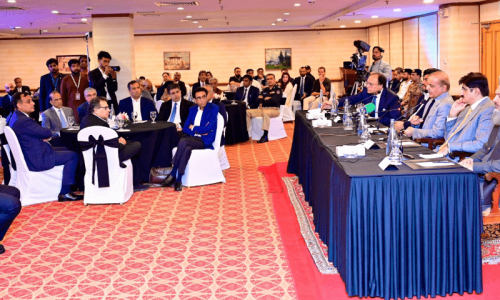 ISLAMABAD, Oct 9: The magnitude of the disaster caused by Saturday’s massive earthquake stunned the nation as the first relief teams reached the worst-hit areas in Azad Kashmir and northern Pakistan on Sunday.
ISLAMABAD, Oct 9: The magnitude of the disaster caused by Saturday’s massive earthquake stunned the nation as the first relief teams reached the worst-hit areas in Azad Kashmir and northern Pakistan on Sunday.
Initial estimates confirmed fears that the death toll would be in the thousand, with official sources citing a tentative figure of 20,000.
Millions of people struck by the tragedy continued to live in awe the day after, as repeated aftershocks and the grim news that about 20,000 people had been counted dead, and 42,000 injured so far, reminded them that the danger was not over.
Interior Minister Aftab Sherpao, who announced the casualty figures to journalists in Islamabad, said they were expected to rise.
Except for some 2,000 who perished in Mansehra and adjoining areas in the NWFP, all the casualties took place in Azad Kashmir, where the epicentre of the killer earthquake lay.
In capital Muzaffarabad, most houses, government buildings and shops had collapsed and frightened residents spent a chilly night camped in fields, parks, graveyards and cars.
A senior United Nations official in Islamabad told Dawn that the death toll in the AJK might well exceed 30,000.
“About four million people have been affected by the quake. The loss in five Azad Kashmir districts and six northern districts of NWFP is colossal,” said Zafar Iqbal, the Assistant Resident of the United Nations system in Pakistan, quoting the estimates prepared by the disaster and crisis management cell of the body which he heads.
Seismographs in the country have registered 125 aftershocks — only a few of them perceptible — since the main quake hit the region at 8.52am on Saturday.
Meanwhile, international community has joined the massive rescue and relief operations undertaken by the Pakistan government and which has been facing difficulties because of broken and blocked roads and bridges and shortage of relief materials.
A British Rapid Rescue team went into action at the site of the residential building which had collapsed in Islamabad. So far 21 bodies and 100 trapped residents have been brought out from the debris of the 11-storey building.
China, Russia, Germany and Saudi Arabia are also sending teams.
Turkish and United Arab Emirates teams have already arrived who were immediately despatched to Muzaffarabad and Mansehra, the worst-affected areas.
Almost 70 per cent of the buildings in Muzaffarabad, capital of Azad Kashmir, have been destroyed or damaged, according to the presidential spokesman, Major Gen Shaukat Sultan, who took foreign media on a helicopter tour of the devastated areas.
Television pictures of the areas indicated the massive relief effort required as hundreds of children were believed buried under collapsed schools and people trapped in destroyed mud-houses and concrete buildings in isolated villages and towns in the quake-hit areas.
Apparently stung by the opposition’s accusations that the government was unprepared and responded late and inadequately to the crisis, President Gen Pervez Musharraf said during an aerial tour of the devastated areas that “instead of blame game this worst national tragedy demands united action to overcome it”. He sought understanding of the difficulties that the rescue efforts were facing.
The opposition had been increasingly attacking Gen Musharraf ahead of the sixth anniversary of his takeover of the country which falls on October 12.
Some 25 helicopters, belonging to army aviation, the air force and the crisis management cells were already in operation taking relief workers and materials to the needy and bringing back the seriously injured.
Many hospitals, including those run by the military in Muzaffarabad and Rawlakot, were destroyed by the quake.
Army’s Corps of Engineers and the Frontier Works Organization have started removing the landslides that have blocked the two main access roads to Muzaffarabad via Abbottabad and Murree.
Prime Minister Shaukat Aziz told journalists after an aerial survey of the devastated area that opening of the roads was essential as helicopters could deliver goods quickly but their load capacity was limited. Massive quantities of food and shelter material were needed not only for the victims of the quake but also tens of thousands other made homeless by it.














































Dear visitor, the comments section is undergoing an overhaul and will return soon.